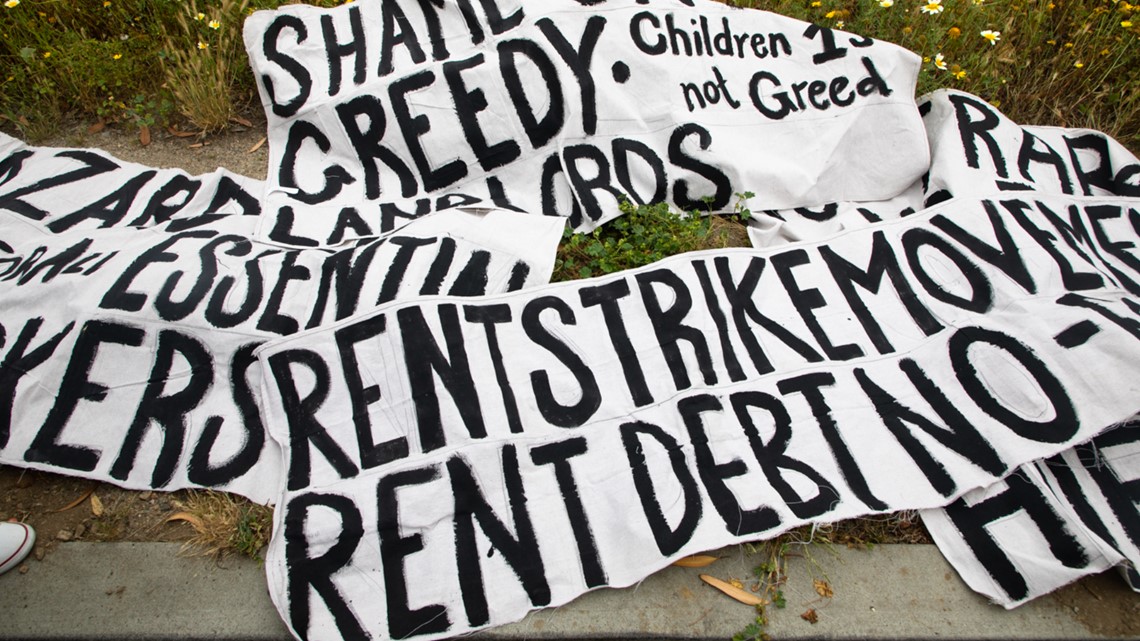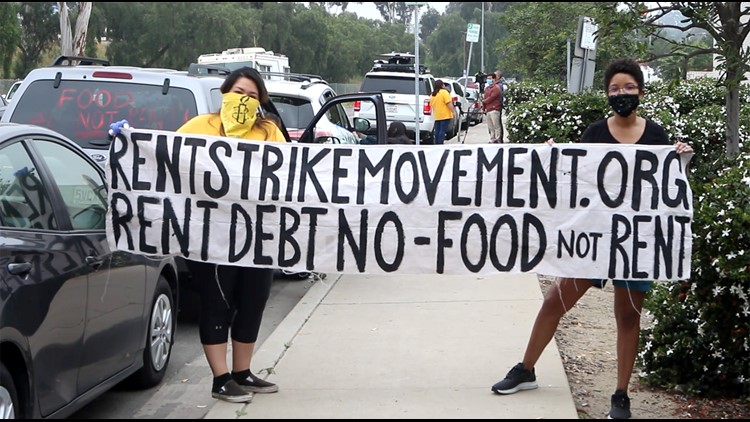SAN DIEGO — In late June, three months into the coronavirus pandemic, the San Diego City Council touted its new emergency rental assistance program and agreed to pay about two months of rent for at least 3,500 low-income households.
Payments were supposed to be sent to the renters’ landlords by Sept. 25. It hasn’t exactly worked out that way.
The $15.1 million program overseen by the San Diego Housing Commission was rife with delays, leaving $1.5 million unspent as of last week and more than 400 families waiting for assistance. The City Council wasn’t told about the problems until inewsource started asking questions.
Community advocates working with the renters also said the available funding doesn’t come close to preventing the wave of evictions expected when moratoriums in California are lifted in February.
“We’re in a crisis,” said Al Abdallah, chief operating officer at the Urban League of San Diego County, one of eight nonprofits hired to help renters apply for the relief.
“Now is the time to put your money where your mouth is as an elected official, come together devoid of partisanship and get resources to the community,” he said.
How COVID-19 rent relief unfolded
Due to the COVID-19 pandemic, more than 400,000 people in the San Diego region were out of work by mid-May. Many were struggling to pay their bills and rent.
In response, the City Council directed staff to start working on a rent relief program. Half of San Diego’s households are renters, with two out of three considered low income.
The initial proposal called for $61.9 million of federal coronavirus aid — an amount that would have benefited 15,475 households, city documents show.
But Mayor Kevin Faulconer rejected that amount, instead setting aside $10.4 million for rent assistance in his fiscal 2021 budget. The City Council added $4.7 million to the program before passing the final budget in June.
The funding amounted to 6% of the $248 million the city received in federal coronavirus aid.
Faulconer’s office told inewsource the city faced a historic deficit due to the pandemic. How to spend that federal aid required difficult decisions among competing priorities such as childcare for essential workers, moving homeless people sheltered at the San Diego Convention Center into permanent housing, and a small business relief fund.
The rent relief program was just one way the mayor responded to residents’ needs, Faulconer spokeswoman Rebecca Rybczyk said. Every qualified household that applied for the assistance received it using the funds available, she said.
Councilmember Chris Ward, who introduced the initial proposal, cast the only “no'' vote on the mayor’s annual budget for the city, saying he was disappointed more rent relief money wasn’t going to help struggling families.


But by the end of June, the council gave the $15.1 million in rent relief money to the San Diego Housing Commission and tasked the agency with disbursing payments to the landlords of eligible low-income tenants.
The council recognized it didn’t go far enough.
“As we’re starting this conversation, we need to figure out how we can allocate more resources as time moves forward,” Council President Georgette Gómez said.
By October, the council agreed to add $5 million to the program, but it’s unclear when that money will be available to spend.
What council members didn’t know at the time was the Housing Commission hadn’t yet spent $9 million from the first round of funding, leaving roughly 2,400 households waiting for help.
Housing Commission and nonprofits team up
Housing Commission officials anticipated that they would be asked to oversee the rent relief program and worked with a Redondo Beach company to create an application portal, agency spokesperson Scott Marshall said.
The portal was customized to ensure thousands of applications could be submitted and reviewed by the commission. It also included a way to send payments — a one-time direct deposit of $2,000 or $4,000, depending on the applicant — to landlords, Marshall said.
Commission President Rick Gentry had assured the council in June that procedures were in place to launch the program quickly.
“There’s always a tension between trying to get the work done quickly and trying to get it done in a thorough, comprehensive fashion. We’ll do our best to strike that balance,” Gentry added.
The portal cost $250,000 — taken from the rent relief allocation — and began accepting applications on July 20. Renters had 19 days to apply.
Applicants had to meet several requirements, including no participation in any other rental assistance program and qualifying as low income. For a family of four, that means an annual income of less than $69,300. They also had to show proof of financial hardship due to COVID-19.


The commission contracted with eight community-based nonprofits to help applicants through the process and gave them about a week to prepare for the demand. By Aug. 7, the deadline to apply, the agency had received roughly 8,300 applications, with about 5,300 appearing to qualify.
“There were days we would get like 80 calls, and we couldn’t get back to them that very same day,” said Leticia Leal, resident services program manager for the nonprofit City Heights Community Development Corporation.
That would cut into a person’s application deadline. Much of the work involved helping people upload documents or answering questions about their eligibility. But the sheer influx of people asking about the program was overwhelming, Leal said.
“It would have been helpful to have more time to kind of prepare to be a supporting organization,” she said.
Roberto Alcantar, chief strategy officer with the Chicano Federation, said his team was only given a couple of days to prepare. Once the program started, phones were ringing off the hook, he said.
On a typical Monday morning, staffers would come into the office with some 30 voicemails to return from people seeking assistance. They had about 450 voicemails waiting for them on the Monday when the application portal opened, Alcantar said.
“Pretty much it was all hands on deck,” he said.
Abdallah, with the Urban League, said he would have liked to have had more than one week to ramp up a major program, but he didn’t ask questions.
“My goal was to make sure we were available for the community to get the assistance that was desperately needed,” he said. “I was more concerned with the end game as opposed to, ‘How did we get here?’”
The Housing Commission didn’t explain to inewsource why the nonprofit partners were not given more time. Each of the eight groups was paid $25,000 from the rental assistance program for helping applicants.
The commission was allowed to spend up to 10%, or $1.5 million, of the program’s funding on administrative costs, which included the application process. Most of that money was used to hire 19 temporary employees.
After reviewing all rent relief applications, the commission determined 3,700 households would benefit from the program.
The San Diego Housing Commission started sending rent relief payments to the landlords of eligible low-income tenants in September. The graphic shows the number of payments and total amount sent to each ZIP code as of Oct. 23.
City Council members received the first notice of a delay in payments on Sept. 3. Housing Commission Executive Vice President Jeff Davis told them in an email that roughly 85% of the applications processed to that point were eligible for help.
“We anticipate disbursing payments to the majority of eligible households by the end of September, with some payments made to landlords on their tenant’s behalf through October,” Davis said.
inewsource started asking the commission questions about the program on Oct. 23 after obtaining records that showed $4 million still hadn’t been spent and about 1,100 households were still waiting for assistance.
Less than two hours later, Davis sent council members another email.
“In an email to you in September, I let you know that (the Housing Commission) expected some payments to be made to landlords on their tenant’s behalf throughout the month of October. At this stage, it is possible that some payments will be through November,” he said.
Local response called ‘very insufficient’
The first landlord didn’t receive a rent relief payment until Sept. 10, records show.
The commission blames the delay on the time it took to process applications, verify eligibility and coordinate with landlords. But the agency also had to stop sending payments four weeks into the program to ensure it was properly collecting data required by the federal government.
Because some of the coronavirus relief funding came from a Community Development Block Grant, that meant applicants needed to provide demographic information, including race, ethnicity and gender.
The commission didn’t know block grant funds were being used when the application portal was created, Marshall said. Once that was realized, staff had to go back and collect that information from recipients, he said.
“As with any new program of this size, adjustments may be necessary to address needs as they arise,” Marshall said.
As of last week, the commission still had $1.5 million to spend and more than 400 families waiting on assistance.
Laura Ann Fernea, executive director of the City Heights CDC, stressed that nearly eight months into the pandemic the assistance program only covers two months of rent for a select few.
“The local response just was very, very insufficient,” Fernea said.
Abdallah said missed rent payments will continue piling up as unemployment numbers remain high. He said families will wind up homeless if the city doesn’t provide more aid.
“What about the next 18 months?” he said. “This isn’t going anywhere and people are going to continue to be out of work.”
Have you applied for San Diego’s rent relief program? We want to hear from you. Send information about your situation to Cody Dulaney at codydulaney@inewsource.org.



